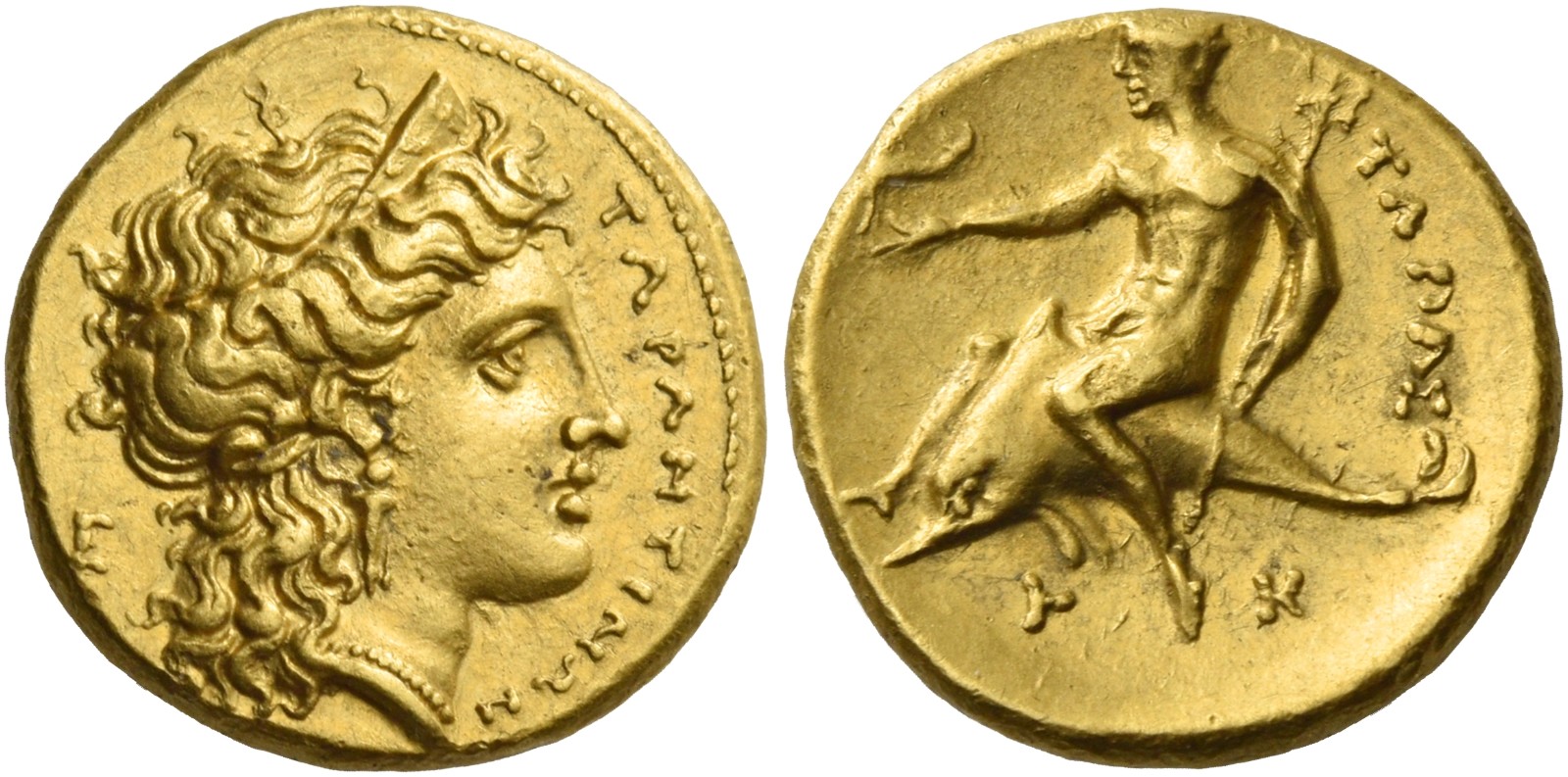Taras, gold, hemistaters (320-315 BCE)
From SILVER
320 BCE - 315 BCE Gold 8,322 kg
Description
| ObverseInscription or printing placed on the obverse.: | TAPANTINΩN (G6-7) ; TAPA (G12-13) (Greek).TAPANTINΩN Head of Hera r., wearing stephane, triple-pendant earring and necklace, in l. field, E. |
| ReverseInscription or printing placed on the reverse.: | TAPAΣ (G6-7) ; TAPANTINΩN (G27-33) (Greek).TAPAΣ Dolphin rider l., holding small dolphin on outstretched r. hand and trident in l., below, T – K. |
Mint and issuing power
| MintIdentifies the place of manufacture or issue of a numismatic object.: | Taras | Ancient regionAncient region.: | Calabria | Modern countryModern country: Italy | AuthorityIdentifies the issuing power. The authority can be "pretended" when the name or the portrait of X is on the coin but he/she was not the issuing power. It can also be "uncertain" when there is no mention of X on the coin but he/she was the issuing power according to the historical sources: |
Chronology
| FromIdentifies the initial date in a range assigned in a numismatic context. | 320 BCE | toIdentifies the final date in a range assigned in a numismatic context.. | 315 BCE | PeriodTime period of the numismatic object.: Hellenistic 323-30 BC |
Physical description
| MetalThe physical material (usually metal) from which an object is made.: | Gold |
Median weightMedian of the weights of numismatic objects (in grams). in grams | 4.25 | DenominationTerm indicating the value of a numismatic object. Examples: tetradrachm, chalkous, denarius.: | hemistater |
StandardStandard.: |
Image

S 844 - Taras, gold, hemistater, 320-315 BC.jpg [1]
References
| Die study referencePublication of the study: | Fischer-Bossert 19991Fischer-Bossert 1999, p. 350-363, G6-G7, G12-13, G27-33. | ||
| Coin series referenceReference to coin series study: | HN Italy2HN Italy, n° 902, HGC 13HGC 1, n° 736 | ||
| Coin series web referenceCoin series web references: | |||
Obverse dies distribution
| FrequencyFrequency of specimen in distribution. ᵖ | Number of obversesNumber of obverse dies. ᵖ (o) | % (o) | Number of coinsNumber of coins. (n) | % (n) | Die nameName(s) of the die(s). |
| 4 | 2 | 20 | 8 | 4.55 | 23, 32 |
| 7 | 1 | 10 | 7 | 3.98 | 25 |
| 8 | 1 | 10 | 8 | 4.55 | 5 |
| 10 | 1 | 10 | 10 | 5.68 | 27 |
| 15 | 1 | 10 | 15 | 8.52 | 24 |
| 22 | 1 | 10 | 22 | 12.5 | 29 |
| 24 | 1 | 10 | 24 | 13.64 | 26 |
| 37 | 1 | 10 | 37 | 21.02 | 6 |
| 45 | 1 | 10 | 45 | 25.57 | 10 |
| Total | 10 of 10 | 100 | 176 of 176 | 100.01 |
Reverse dies distribution
| FrequencyFrequency of specimen in distribution. ᵖ | Number of reverse diesNumber of reverse dies. (r) | % (r) | Number of coinsNumber of coins. (n) | % (n) | Die nameName(s) of the die(s). |
| 4 | 2 | 18.18 | 8 | 4.55 | 27;32 |
| 7 | 1 | 9.09 | 7 | 3.98 | 29 |
| 8 | 1 | 9.09 | 8 | 4.55 | 6 |
| 10 | 1 | 9.09 | 10 | 5.68 | 31 |
| 15 | 2 | 18.18 | 30 | 17.05 | 13;28 |
| 22 | 1 | 9.09 | 22 | 12.5 | 33 |
| 24 | 1 | 9.09 | 24 | 13.64 | 30 |
| 30 | 1 | 9.09 | 30 | 17.05 | 12 |
| 37 | 1 | 9.09 | 37 | 21.02 | 7 |
| Total | 11 of 11 | 99.99 | 176 of 176 | 100.02 |
Quantification
| Number of obversesNumber of obverse dies. ᵖ (o) | 10 | Number of singletons (o1)The number of singleton coins. ᵖ | |
| Number of reverse diesNumber of reverse dies. (r) | 11 | Number of coinsNumber of coins. (n) | 176 |
| Coins per obverse dieNumber of coins per obverse die. (n/o) | 17.6 | Coins per reverse dieNumber of coins per reverse die. (n/r) | 16 |
| Reverse per obverse ratioRatio of obverse dies divided by reverse dies. (r/o) | 1.1 | Percentage of singletons (o1)number of coins (n) divided by the number of singletons (o1) ᵖ | % |
| Original number of dies (O) (Carter 1983 formula)The estimation of the number of coins according to Carter 1983 ᵖ | 9.79 | Coins struck if 20,000 as average productivity per dieCoins made if the average productivity for obverses (according to Carter) is 20,000. ᵖ | 195,800 |
| Original number of dies (O) (Esty 2011 formula)The estimation of the number of coins according to the singleton formula in Esty 2011 ᵖ (O) | 10.6 | Survival rate if 20,000 as average productivity per dieSurvival rate if average productivity is 20,000. ᵖ | 0.00090 |
| Coverage (o = % of O) (Esty 1984 formula)Esty 1984 - coverage (% of O) ᵖ (o = % of O) | % | Die productivity if survival rate 1/2,000Average productivity if survival rate is 1/2,000. ᵖ | 35,955.06 |
| Weight of silver (in kg) if 20,000 coins per die (O = Carter formula)Carter 1983 * Median weight * 20000 (*10 if gold or electrum) ᵖ | 8,322 kg <br /> 8,322 kg | Die productivity if survival rate 1/5,000Average productivity if survival rate is 1/5,000. ᵖ | 89,887.64 |
Remarks
Most likely one single workstation Likely military